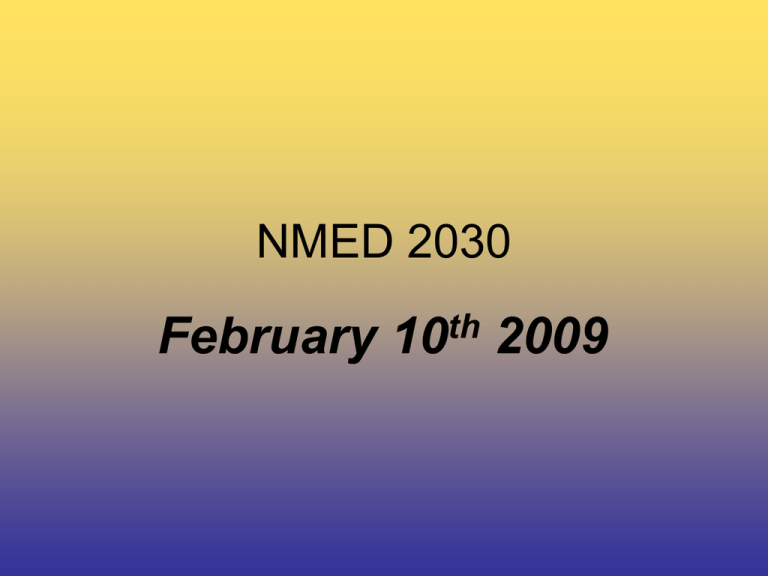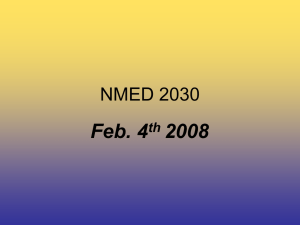February 10 2009 NMED 2030 th
advertisement

NMED 2030 February 10th 2009 NMED 2030 Today’s Class… Sound Design CBS Sunday Morning Audio Assignment NMED 2030 – The War of the Worlds is an episode of the American radio drama anthology series Mercury Theatre on the Air, which was performed as a Halloween special on October 30, 1938 and aired over the CBS Radio network. Directed by Orson Welles, the episode was an adaptation of H. G. Wells' classic novel The War of the Worlds. – New York Times headline from October 31, 1938. NMED 2030 • Sound Design – The term “sound designer” was coined by famed editor, Walter Murch (Apocalypse Now, The Conversation, The English Patient) in 1979. – Sound design is an integral part of the filmmaking and film watching experience. – The appeal to the imagination of the creators and the audience. NMED 2030 • Foley Art – The use of sound effect technique for synchronous effects or live effect is called Foley art. – Foley art is named for Jack Foley a sound editor at Universal Studios who died in 1967. NMED 2030 • Foley Art – Foley got the idea of projecting the moving image in a sound stage and recording sounds and recording in sync with the actors movements using different surfaces and an array of props. NMED 2030 • Foley Art – Did you know that… • The sound of a smoldering cigarette is made by pressing a thumb into plain dirt? • The mammoth’s footsteps in the movie The Ice Age was made by dropping a log into a pit of dirt, mud and stone? • In Crouching Tiger, Hidden Dragon the bamboo sticks used in the balletic fight scene came from a sound editor’s backyard in New Jersey? NMED 2030 • Foley Art – Did you know that… • The sound of footsteps crunching on snow is actually achieved by Kosher sea salt covered in corn starch? • The sound of the dragonfly made memorable in the opening of Men In Black was made using a small plastic fan with gaphers tape stuck to the blades? The tape was made long enough so that when the fan was turned on, it brushed up against the Foley’s fingers. NMED 2030 • Foley Art – Today Foley effects are done predominantly without Foley performers. – The sounds are stored electronically and performed by the post-production team. NMED 2030 • You will be asked to record a line of dialogue that captures the spirit of your scene and recreate the environment using sound effects. NMED 2030 • Homework… • Come to next class prepared to begin your audio assignment. – The assignment will be given during the lecture part of the class and you will be set free to begin creating during the lab. NMED 2030 • CBS Sunday Morning • http://www.youtube.com/watch?v=_a5Z UqjnRvE • December 17, 2007 NMED 2030 • Derek Jarman’s Blue The film was his last testament as a filmmaker, and consists of a single shot of saturated blue colour filling the screen, as background to a soundtrack NMED 2030 • Audio Assignment 1. Break into groups of two or three 2. Each group needs to check-out a camera. 3. Take turns recording your respective lines of dialogue using the Panasonic in-camera microphone. 1. Find a quiet, sound controlled room or area 4. Return the camera to the equipment room by the end of class. NMED 2030 • Audio Assignment 5. Steps for Recording Dialogue: • • • • Write down your line of dialogue One person is responsible for hitting the record/pause button One person is responsible for saying i.e. “Dana’s dialogue: Take One” etc. then reciting the dialogue One person is responsible for taking notes on which take is “good” or “very good” or “junk” 4. Do at least three takes – but no more than ten NMED 2030 • Audio Assignment 6. Import the dialogue into Premiere Pro • Edit for dramatic effect if necessary – Create pauses, change pitch or speed etc. NMED 2030 • Audio Assignment 8. Using the sound effects from California State University, The Free Site.com http://www.grsites.com/sounds/ OR create Foley sounds to create the environment in which you story unfolds. NMED 2030 • Audio Assignment is due at the end of class on Feb 12th • To submit, put your final assignment in your class folder.

